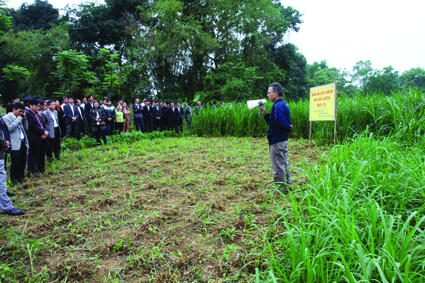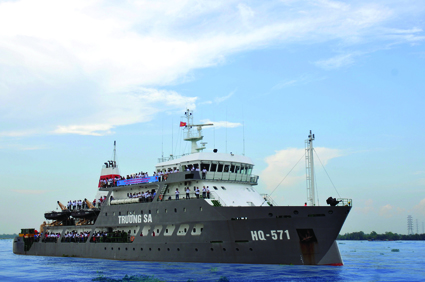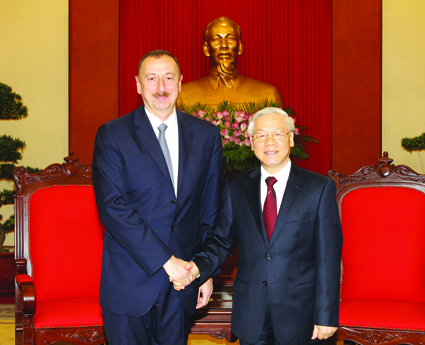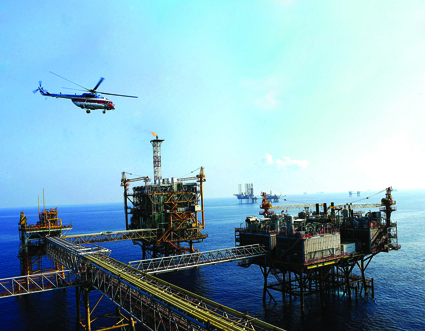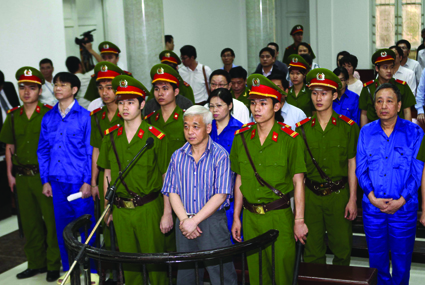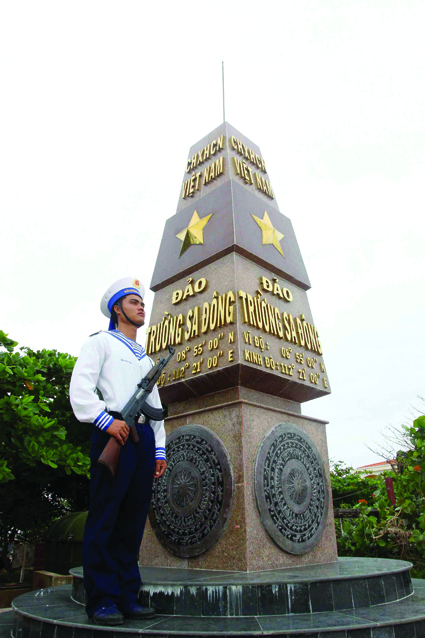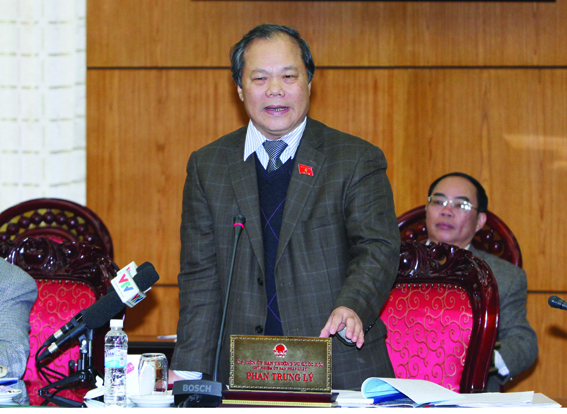Tran Si Vy
Lawyer at Leadco Legal Counsel
BACKGROUND
On 2 May 2014, China moved its giant oil rig, Haiyang Shiyou 981 (“HD 981”), to the waters near the Paracels islands (aka “Xisha” as they are called by China or “Hoang Sa” as they are called by Vietnam[1]). This triggered a formidable dispute over the sovereignty issues that Vietnam and China have had for years. The international press calls the location where China placed HD 981 “disputed water,” while neither Vietnam nor China accepts this definition, as each claims sovereignty over this area.

on July 25 and 26 in Ho Chi Minh City__Photo: Trang Duong/VNA
Geographically, HD 981 was moved in and placed at co-ordinates 15°29′58″B 111°12′1″D on 2 May 2014[2], 17 nautical miles from Triton (aka “Zhongjian” as it is called by China or “Tri Ton” as it is called by Vietnam[3]), one of the islands in the Paracels (the area disputed between China and Vietnam), 180 nautical miles south of China’s Hainan island and 120 nautical miles east of Vietnam’s Ly Son island. The Paracels have been controlled by China since 19 January 1974.
CHINA’S POSITIONS
On 8 June 2014, the Ministry of Foreign Affairs of China provided a declaration titled “The Operation of the HYSY 981 Drilling Rig: Vietnam’s Provocation and China’s Position” (“China’s Position Paper”[4]). In this document, China asserts that (1) the operation of its oil rig south of Triton of the Paracels islands is a normal activity of an enterprise of China, (2) the Paracels are inherently part of China’s territory, over which there is no dispute, and (3) the water [where HD 981 is placed] will never become Vietnam’s exclusive economic zone (EEZ) and continental shelf no matter which principle is applied in the delimitation.[5]
VIETNAM’S POSITIONS
On July 3, 2014, Vietnam produced a paper titled “China’s illegal placement of HD 981 oil rig in the EEZ and continental shelf of Vietnam” (Vietnam’s Position Paper[6]). In this document, Vietnam reiterates that (1) China’s activities, in violation of international law, escalate tension in the East Sea (South China Sea) and (2) Vietnam’s efforts and goodwill to settle the current tension through dialogue and other peaceful means have been repeatedly rejected by China.[7]
LEGAL BASIS OF THE PARTIES
The cause of dispute over the operations of HD 981 is that both Vietnam and China claim that the water where this oil rig is placed is their own territory, from which the sovereignty rights of each country should be exercised. Each of the parties, therefore, provides its own legal basis and foundation to support its claims.
Legal basis of China
China claims that it has sovereignty over the Paracels and their surrounding waters and that the operation of HD 981 in no way violates any international laws. More specifically, China states that the “location of the oil rig is 17 nautical miles from both the [Triton] island of the [Paracels] and the baseline of the territorial waters of the [Paracels], yet approximately 133 to 156 nautical miles away from the coast of the Vietnamese mainland.”[8] China’s position on sovereignty over the Paracels is upheld by the claim that “prior to 1974, none of the successive Vietnamese governments had ever challenged China’s sovereignty over the [Paracels] islands.”[9]
Legal basis of Vietnam[10]
Vietnam relies upon, among other things, three historical facts and legal considerations to assert that the Paracels belong to its sovereignty, from which it concludes that the water where HD 981 is placed is within its territory. First, the sovereignty of Vietnam over the Paracels has been largely recognized by the global community through certain international treaties, of which San Francisco Peace Treaty 1951 is one example.[11] Second, the Geneva Agreement on cessation of hostilities in Vietnam dated 20 July 1954 (Geneva Agreement)[12] gave administration for occupancy and management of the Paracels to Vietnam.[13] Third, the Paracels battle in 1974 between the Navy of China and that of Vietnam (the Paracels Battle)[14] was evidence to the world that China took the territory of Vietnam in a violent and illegal manner. No sovereignty should be achieved by violence no matter what the reason is.
In addition, Vietnam points to certain provisions of the 1982 United Nations Convention on the Law of the Sea (the UNCLOS)[15] concerning the regimes of the EEZ and the continental shelf and the solution for the coastal countries to delimit the overlapped EEZs to found its legal basis for the dispute.
LEGAL ANALYSIS
Sovereignty over the Paracels
On September 5, 1951, an international conference was held in San Francisco (San Francisco Conference) to discuss a peace treaty with Japan following the end of World War II. At this conference, the Minister of Foreign Affairs of the Soviet Union proposed 13 amendments, one of which referred to Japan’s recognition of China’s sovereignty over the Paracels.[16] This amendment was strongly rejected by the attending countries at the conference with 48 noes and 3 ayes in total 51 votes.[17] Subsequently, on September 7, 1951, the Prime Minister and concurrently the Minister of Foreign Affairs of the State of Vietnam[18], Tran Van Huu, made a solemn declaration to the San Francisco Conference that the Paracels and the Spratlys were territories of Vietnam.[19] The fact is none of delegates of the San Francisco Conference objected to this declaration.[20] This is to say the sovereignty of Vietnam over the Paracels, to some extent, was largely acknowledged by the global community.
On July 20, 1954, some giant players in world politics organized a conference in Geneva to discuss the cessation of hostilities in Vietnam, with China as one of the attendees. Article 1 of Geneva Agreement provides that “a provisional military demarcation line[21] shall be fixed, on either side of which the forces of the two parties shall be regrouped after their withdrawal, the forces of the People‘s Army of Vietnam to the north of the line and the forces of the French Union to the south.”[22] That provisional military demarcation line between the two final regrouping zones was extended into the territorial waters by a line perpendicular to the general line of the coast in accordance with Article 4 of Geneva Agreement. Article 14 of Geneva Agreement also confirms that “pending the general elections which will bring about the unification of Vietnam, the conduct of civil administration in each regrouping zone shall be in the hands of the party whose forces are to be regrouped there in virtue of the present Agreement.”[23] Pursuant to those provisions of Geneva Agreement, the Paracels, as territory set beneath the 17th parallel to the south of Vietnam, were put under administration of the southern government (the government of the State of Vietnam and later the Republic of Vietnam[24]). It should be noted that by the time the Republic of Vietnam was given the authority to manage the Paracels according to the Geneva Agreement, these islands had not been occupied by armies of any countries other than the French army.[25]
On January 19, 1974, the Paracels Battle took place, with China’s navy actively attacking the navy of the Republic of Vietnam and eventually occupying the islands after the battle.[26] It is a fact that before the Paracels Battle, the Ministry of Foreign Affairs of China had, on January 11, 1974, declared that the Paracels and the Spratlys (aka “Nansha” as they are called by China or “Truong Sa” as they are called by Vietnam[27]) were the territories of China and accused Vietnam of illegally occupying those islands.[28] Subsequently, Vietnam had responded by a declaration to affirm the Paracels and the Spratlys to be territories of Vietnam and further refuted the accusation of China.[29] From January 16, 1974 to January 19, 1974, China deployed manpower and war-ships to attack and kill 75 soldiers of Vietnam to capture the Paracels.
China’s attack to usurp the Paracels, in fact, has seriously violated the Charter of the United Nations, which provides that “all members shall settle their international disputes by peaceful means in such a manner that international peace and security, and justice, are not endangered”30 and “all members shall refrain in their international relations from the threat or use of force against the territorial integrity or political independence of any state, or in any other manner inconsistent with the purposes of the United Nations.”[30] No sovereignty is achieved by way of violence using force in any circumstances by any legal considerations and international rules.
In its Position Paper, China also argues that “prior to 1974, none of the successive Vietnamese governments had ever challenged China’s sovereignty over the Paracels islands.”[31] This argument seems to reach the people’s ears once first heard but is unreasonable once reconsidered. For the period from 1954 to 1974, the Democratic Republic of Vietnam[32] did not directly occupy and manage the Paracels, so its silence on the issues of sovereignty over these islands was understandable.[33] The Republic of Vietnam, the government actually occupying and administering the Paracels in accordance with Geneva Agreement at that time, had made a number of declarations concerning the sovereignty of Vietnam over the Paracels. For instance, on January 11, 1974, China made a declaration to claim its sovereignty over the Paracels and the Spratlys[34]. In response, the government of the Republic of Vietnam, on January 12, 1974, refuted those claims from China.[35] Additionally, on January 16, 1974, the government of the Republic of Vietnam made a declaration to refute the positions of China’s sovereignty over the Paracels and showed certain evidence in relation to laws, geography and history for the determination of sovereignty of Vietnam over these islands.[36] Those perspectives show that the argument of China that none of the successive Vietnamese governments had ever challenged China’s sovereignty over the Paracels islands does not stand firm on its feet.
It is not necessary to discuss the national succession or inheritance issues as Vietnam has been the only one having sovereignty over the Paracels irrespective of the presences of two governments during the period 1954-1975. Section 7 of the Final Declaration of the Geneva Conference stated that “the conference declares that, so far as Vietnam is concerned, the settlement of political problems, effected on the basis of respect for principles of independence, unity and territorial integrity [of Vietnam]…[37]” The unity and territorial integrity of Vietnam was reiterated in the Paris Peace Accords on ending the war and restoring peace in Vietnam dated 27 January, 1973 (Paris Peace Accords). More specifically, Article 1 of the Paris Peace Accords stated that “the United States and all other countries respect the independence, sovereignty, unity, and territorial integrity of Vietnam as recognized by the 1954 Geneva Agreement on Vietnam.[38]”
Regimes of the EEZ and the continental shelf under the UNCLOS
Setting aside the issues concerning the sovereignty over the Paracels, now, we should review the relevant provisions of the UNCLOS on regimes of the EEZ and the continental shelf to figure out the positions of each party. According to Article 57 of the UNCLOS, “the EEZ shall not extend beyond 200 nautical miles from the baselines from which the breadth of the territorial sea is measured.” The fact is that HD 981, installed at the location of less than 120 nautical miles from the coastline of Vietnam, which completely falls within the EEZ of Vietnam.

Additionally, according to Article 76 of the UNCLOS, “the continental shelf of a coastal state comprises the seabed and subsoil of the submarine areas that extend beyond its territorial sea throughout the natural prolongation of its land territory to the outer edge of the continental margin, or to a distance of 200 nautical miles from the baselines from which the breadth of the territorial sea is measured where the outer edge of the continental margin does not extend up to that distance.” Under the UNCLOS, the coastal state has exclusive rights in exploring and exploiting the natural resources in the continental shelf. This is well recognized by Article 77.2 of the UNCLOS, which reads as follow: “if the coastal state does not explore the continental shelf or exploit its natural resources, no one may undertake these activities without the express consent of the coastal state”. That China moved its oil rig to the area falling within 200 nautical miles from the coastline of Vietnam to explore the oil and gas without consent of Vietnam should in no way be construed, as it stated to the world, a “normal activity” of a Chinese enterprise.
Delimitation of overlapping EEZs
According to Article 121.3 of the UNCLOS, “rocks which cannot sustain human habitation or economic life of their own shall have no EEZ or continental shelf.” Now, lets review the particulars of Triton island, whose distance is about 17 nautical miles from HD 981 of China. According to certain documentation of China, Triton is down-sand, with a length of 1,850m counting from the north to the south edge of the island with the breadth of 88m[39] and the average height of 2m[40]. Triton is usually submerged, especially when there is a storm about to pass by. The island itself is dry and provides hard conditions for plants to grow and survive.[41] Having such difficult geographical and biological particulars, Triton cannot meet the qualification as specified in Article 121.3 of the UNCLOS to have an EEZ and continental shelf for its own. Instead, Triton might only have a territorial sea of 12 nautical miles from its baseline. Even if China was assumed to have sovereignty over Triton as it so claims, still, it is hard to convince the world that the location of HD 981 is within the territory of China because it is beyond 12 nautical miles (instead, it is 17 nautical miles) from Triton. While it is uncertain for China to prove the legality of the location of HD 981, Vietnam’s position on the same should be stronger as HD 981 absolutely no doubt falls within the EEZ of Vietnam, irrespective of whether Vietnam has or does not have sovereignty over the Paracels.
Stubbornly, China still could argue that, apart from Triton, certain islands claimed to be parts of China in the Paracels, for example, Woody island (aka Yongxing as it is called by China and Phu Lam as it is called by Vietnam[42]), should be eligible to enjoy the regime of EEZ. Woody is the largest island of the Paracels and is the location where China tries its utmost to upgrade and provide certain construction works to make it “sustain human habitation or economic life of its own” so as to claim an area of 200 nautical miles for its EEZ.[43] The location of HD 981, as declared by China, is 103 nautical miles from Woody island, which seems to be nearer than the distance from it to the coastline of Vietnam, approximately 120 nautical miles away.
Perhaps China’s intention was that the location of HD 981 was within its territory if Woody island was eligible to have an EEZ and that it is nearer to the Paracels than the coastline of Vietnam. However, the position of China is uncertain in this regard. Regarding the delimitation of borderlines on the sea, many precedent cases show that the coastline has prevailed over islands in determining the internal waters, territorial sea, contiguous zone, the EEZ and the continental shelf.[44] Therefore, the distance from HD 981 to the coastline of Vietnam should be more important than the distance from HD 981 to the islands in determining the sovereignty of a coastal country.
In the worst case scenario, even if Woody island was assumed to meet the conditions of the UNCLOS to have its own EEZ, it becomes clear that this EEZ overlaps with that of Vietnam. According to Article 74 of the UNCLOS, “the delimitation of the EEZs between states with opposite or adjacent coasts shall be effected by agreement on the basis of international law.” Evidently, Vietnam and China, up to now, have not yet had any agreements on delimitation of the overlapping EEZs. In an absence of agreement on delimitation of overlapped EEZs, Article 71 of the UNCLOS provides that “pending agreement as provided for [delimitation of EEZs], the states concerned, in a spirit of understanding and cooperation, shall make every effort to enter into provisional arrangements of a practical nature and, during this transitional period, not to jeopardize or hamper the reaching of the final agreement.” With such a principle, either party should be obliged to maintain status quo without complicating the situation and unilaterally acting to harm the interests of the other party.
The dispute in relation to sovereignty over the Paracels between Vietnam and China is no doubt a long story. China and Vietnam would not be able to settle the dispute in one day. However, without bias, China’s action in bringing HD 981 to the waters near the Paracels for operation absolutely violates Vietnam’s sovereignty rights and jurisdiction over its EEZ and continental shelf as set forth by the UNCLOS and the international laws largely recognized by the global community, including China.-
[1] Vietnam calls these archipelagoes Hoang Sa while China calls them Xisha. In this article, we will call them the Paracels.
[2] Opposition to China for bringing the oil rig to the sea of Vietnam [China’s Position Paper], Vietnam+, (May 4, 2014).
[3] Vietnam calls this island Tri Ton while China calls it Zhongjian. In this article, we will call it Triton.
[4] The Operation of the HYSY 981 Drilling Rig: Vietnam’s Provocation and China’s Position, The Ministry of Foreign Affairs of China, (June 8, 2014), available at https://www.fmprc.gov.cn/mfa_eng/zxxx_662805/t1163264.shtml
[5] Id. at § III.
[6] China’s Illegal Placement of Haiyang Shiyou 981 Oil Rig in the Exclusive Economic Zone and Continental Shelf of Vietnam, [Vietnam’s Position Paper] The Permanent Mission of Vietnam to the U.N. (07 Jul., 2014), available at https://www.vietnam-un.org/en/vnun.php?id=274.
[7] Id.
[8] China’s Position Paper, supra note 5 at § I. Emphasis added.
[9] Id. at § IV.2. Emphasis added.
[10] This does not reflect the legal positions of the Vietnamese Government. Rather, it is the author’s intention to pick certain legal bases, which are largely held by the public, to discuss in this article.
[11] See, e.g., Treaty with Japan (with Two Declarations), San Francisco, 8 Sept. 1951, 136 U.N.T.S 83, ch. II, art. 2.
[12] Final Declaration of the Geneva Conference, Geneva, [Geneva Agreement] July 21, 1954, The Department of State Bulletin, XXXI, No. 788 (August 2, 1954), available at https://vietnam.vassar.edu/overview/doc2.html.
[13] See id. at art. 6; see also Office of the Secretary of Defense, Vietnam Task Force, United States-Vietnam Relations 1945-1967 [“The Pentagon Papers”](SecDefControl# X-0295/69) The Washington Post, sec. III. D.3, D-20 et seq. (1971), available at https://www.washingtonpost.com/wp-srv/nation/specialreports/pentagon-papers/Pentagon-Papers-Part-III.html (discussing the political context surrounding the Final Declaration.)
[14] See Ngo Minh Tri and Koh Swee Lean Collin, Lessons from the battle of the Paracels islands, THE DIPLOMAT (January23, 2014).
[15] United Nations Convention on the Law of the Sea [UNCLOS III], Montego Bay, December 10, 1982, 1833 U.N.T.S. 3.
[16] See Han Nguyen Nguyen Nha historical circumstances leading to the territorial disputes of Vietnam over the Paracels and Spratlys – causes and solutions, (2009).
[17] See Nguyen Nha, supra, note 17.
[18] State of Vietnam (aka État du Viêt-Nam) was a regime under Indochinese Federation of the French Union and the state that claims authority over all Vietnam, existed during the period 1949 -1955.
[19] See Nguyen Nha, supra, note 17.
[20] See Treaty with Japan, supra, note 12.
[21] The provisional military demarcation line is fixed at 17th parallel (Ben Hai river) as shown on the map attached to Geneva Agreement.
[22] Indochina - Agreement on the Cessation of Hostilities in Vietnam, Jul. 20, 1954, art. 1, IC/42/Rev. 2 (1954).
[23] Indochina Agreement, supra. note 23.
[24] The Republic of Vietnam was the successor of the State of Vietnam and governed the south of Vietnam (from the 17th parallel to the south edge) after the Geneva Agreement in 1954. It had existed until 1975.
[25] Nguyen Nha, supra, note 17.
[26] See Duc Toan The Truth about the Paracels Battle of January 19, 1974, Petrotimes (December 19, 2013).
[27] Vietnam calls these archipelagoes Truong Sa while China calls them Nansha. In this article, we will call them the Spratlys.
[28] New China News Agency: Mao Zedong guided to attack the Paracels in 1974, Vietnam Education Newspaper.
[29] See Ha Van Ngac, Report of the Historical Hoang Sa Battle, Solidarity Monthly Review, Austin, Texas.
[30] U.N. Charter art. 2, sec. 4.
[31] U.N. Charter art. 2, sec. 4.
[32] See China’s Position Paper, supra note 5 at § IV.2.
[33] The Democratic Republic of Vietnam (DRV; Vietnamese: Việt Nam Dân chủ Cộng hòa), generally known as North Vietnam, was a government founded in 1945, comprising most of North Vietnam from September 2, 1945 to December 18, 1946, controlling pockets of territory throughout the country until May 7, 1954, and governing territory north of the 17th parallel until 1976.
[34] Under Geneva Agreement, Vietnam was divided into two parts with the government of Democratic Republic of Vietnam in the north and the Republic of Vietnam in the south. However, Vietnam remained a united country in accordance with Geneva Agreement.
[35] See Nguyen Nha, supra, note 17.
[36] Id.
[37] Id.
[38] See Final Declaration of the Geneva Conference, supra, note 13 at § 7.
[39] Paris Peace Accords (January 27, 1973), U.S. Secretary of State (ed.) United States Treaties and Other International Agreements, 1974, passim.
[40] See Hai Nam Su Chi [Main Section on Paracel Islands and Reefs] (Jun. 11, 2009, 4:32 pm), available at https://www.hnszw.org.cn/data/news/2009/06/43638/.
[41] See “Global times”, dated June 12, 2012.
[42] See Nguyen Nha “The Process to Determine the Sovereignty of Vietnam over the Paracels and the Spratlys”, (Doctor Thesis), on file with the University of Social Science and Humanity (Ho Chi Minh City National University).
[43] Vietnam calls this island Phu Lam while China calls it Yongxing. In this article, we will call it Woody.
[44] See Objection to China for Construction of Certain Work in Woody Island, Vietnam+ (15 June 2014).
